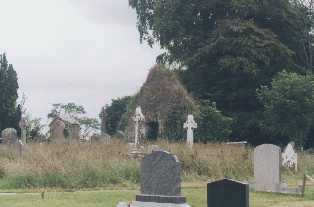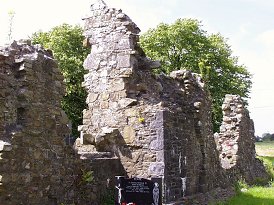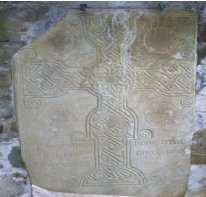| The earliest record of Killagholehane church
is from 1201. In 1302 at the time of the destruction of the church in
Dromcollogher, Killagholehane church was also partially destroyed. It
was rebuilt almost immediately on the same site.
There was also accommodation for priests in a building attached to the
church. There is a tomb in the wall of the church from the fifteenth century
but it is unknown who it belongs to. It may possibly be the tomb of the
O'Daly family, a renowned Bardic family under the employment of the Earls
of Desmond for around 300 years.

© Springfield Church Ruin
Springfield church ruin is located in the graveyard of the
same name. This church, also known as Gortnatubrid, was originally a Chapel
of Ease for the Fitzgerald family in Springfield Castle. In fact an underground
tunnel was located linking the church to the castle. This church became
a Protestant church and both Catholics and Protestants are buried in the
surrounding graveyard.
There is a tomb to the Fitzmaurice family, who acquired the castle after
Sir John Fitzgerald left the country to serve with the Irish Brigade in
France following the Jacobite/Williamite war of 1689-91. He was killed
in battle in Oudenarde in 1708. During the Geraldine Rebellion of 1579,
John of Desmond defeated the English at the Battle of Gortnatubrid in
a field just below the cemetery in Springfield, called Páirc
na Staille.
Over the entrance to Springfield Castle is the motto of the MacCarthy
family which means "To the brave and the faithful, nothing is difficult".
The entrance was inspired by the Maoiri tradition, which Lord Muskerry
came across while working in Australia and New Zealand.

© Tullylease Church Ruin
The church ruins in Tullylease are believed to date from
the seventh century. Tullylease is in the Diocese of Cloyne and is regarded
by many as a boundary point in the Diocese of Limerick. The present diocesan
boundaries were drawn up at the Synod of Rathbrassil in 1111.
The original church at Tullylease was built by St Berechert, an Anglo-Saxon
saint who came to Ireland in the seventh century with St. Gerald of Mayo.
Mathew, son of Grifin built an Augustinian monastery here some time before
1170. Parts of the ruins date from the twelfth (the south end of the east
wall), thirteenth (the window and door in the south wall) and the fifteenth
(the chancel) centuries. According to Séamus Ó Súilleabháin,
the soldiers of Cromwell destroyed the church in or around 1650.

© Inscribed Stone in Tullylease church ruin
On the eastern wall of the church, there is an inscribed
stone that is from the eighth century. It is an early Christian cross-slab
and asks people to pray for Berechert (sometimes called St Benjamin).
Seamus Ó Súilleabháin informs us that the stone
is similar to a scene in the Book of Lindisfarme, an Anglo-Saxon book
similar to Ireland's Book of Kells.
According to John O'Sullivan's book 'A History of the Church in Killagholehane
and Broadford', there was also a church called Killeen, the site of which
was a half mile to the north of Broadford village. However, there is no
longer any trace of the church at the site.
 
|